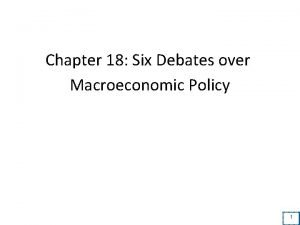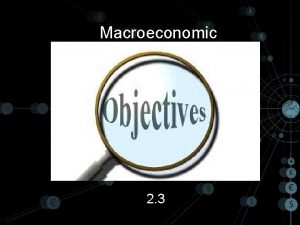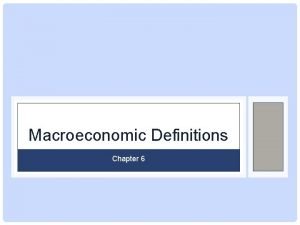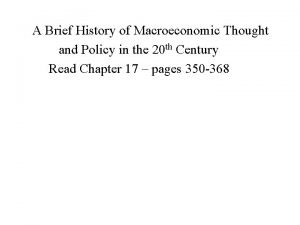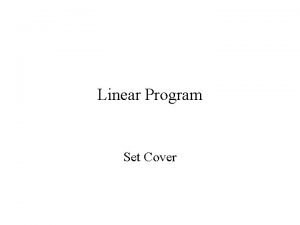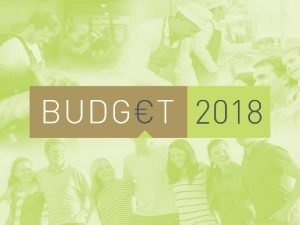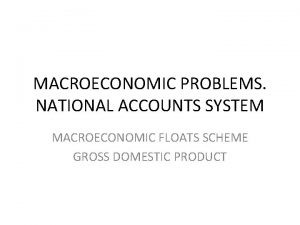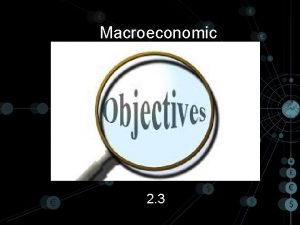The Macroeconomic Framework Given a set of macroeconomic










- Slides: 10

The Macroeconomic Framework Given a set of macroeconomic goals and a policy framework, a macroeconomic framework is a set of sectoral projections (for the real, external, fiscal, and monetary sectors) consistent with each other, consistent with the policy framework, and consistent with the macroeconomic goals

Examples of macroeconomic goals • Preserve macro stability—growth at around 7%, inflation below 5%, keep government debt on a sustainable path, and build-up official reserves • Engineer a soft landing from unsustainable growth rates • Lower inflation to single digits • Fiscal consolidation: Reduce debt to X% of GDP by 2008 • Return the BOP to sustainability by reducing the current account deficit to X% of GDP over the medium term

Elements/examples of a policy framework • Fiscal responsibility legislation • Exchange rate regime • Inflation targeting or reserve money targeting frameworks for monetary policy • Structural policies

Real sector projections • GDP Ø Production approach: GDP= sum of value added across sectors Ø Expenditure approach: GDP=C+I+X-M v. Ensure consistency with fiscal accounts (C and I) and the BOP (X and M) v. Key link with BOP: S-I=CAB where S=National saving=GDP+Net Foreign Income+Net transfers-Consumption

• Prices: CPI and GDP deflator Ø Exchange rate regime Ø What are cost pressures raising prices? Ø What is the stance of economic policies? Ø Estimate impact of changes to regulated prices, competition policy, or trade policy

Forecasting the BOP • Decide appropriate level of disaggregation for projections • Consider developments in economies of main trading partners; terms of trade; competitiveness trends • Consistency with fiscal accounts: Grants and loan disbursements/repayments • Key lines in Bhutan: X and M; Transportation and travel; factor income; remittances and grants; government loans.

Projections for fiscal accounts • Revenues: Ø Tax revenue: First do “passive” projections, based on existing policies. Then, add/subtract from expected policy changes. Ø Non-tax revenue: Key in Bhutan (dividends, profit transfers, and operating surpluses of departmental enterprises). It pays to work out detailed projections by source. Ø Grants: Key in Bhutan. Need to be realistic and coordinate closely with donors. Retain flexibility in executing fiscal policy.

• Expenditures ØKey lines in Bhutan: wages; interest payments; capex; and net lending. • Financing: Foreign—disbursements and amortization; and domestic—bank and non -bank.

Monetary projections • Estimating a demand for money consistent with growth and inflation projections ØP Y=M V • Monetary survey: NFA linked to BOP; Government credit from the fiscal accounts; and private net domestic credit usually a residual. • But is private sector credit growth consistent with growth projections?

Developing a macro framework is an iterative process • Initial projections may expose some tensions/imbalances between outcomes, goals and policies Ø Need to calibrate: v. Nature, seriousness, and source of the imbalances v. Possible rememedies
 Total set awareness set consideration set
Total set awareness set consideration set Training set validation set test set
Training set validation set test set Six debates over macroeconomic policy
Six debates over macroeconomic policy Unemployment
Unemployment Macroeconomic definitions
Macroeconomic definitions History of macroeconomic thought
History of macroeconomic thought 5 debates over macroeconomic policy
5 debates over macroeconomic policy Macroeconomic policy debates
Macroeconomic policy debates Macroeconomic and industry analysis
Macroeconomic and industry analysis A macroeconomic theory of the open economy
A macroeconomic theory of the open economy Five debates over macroeconomic policy
Five debates over macroeconomic policy


